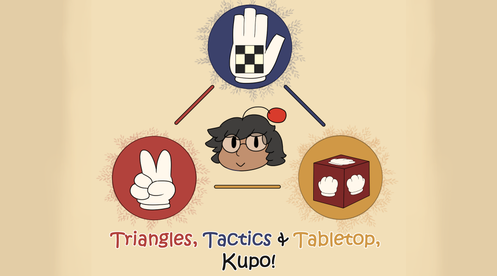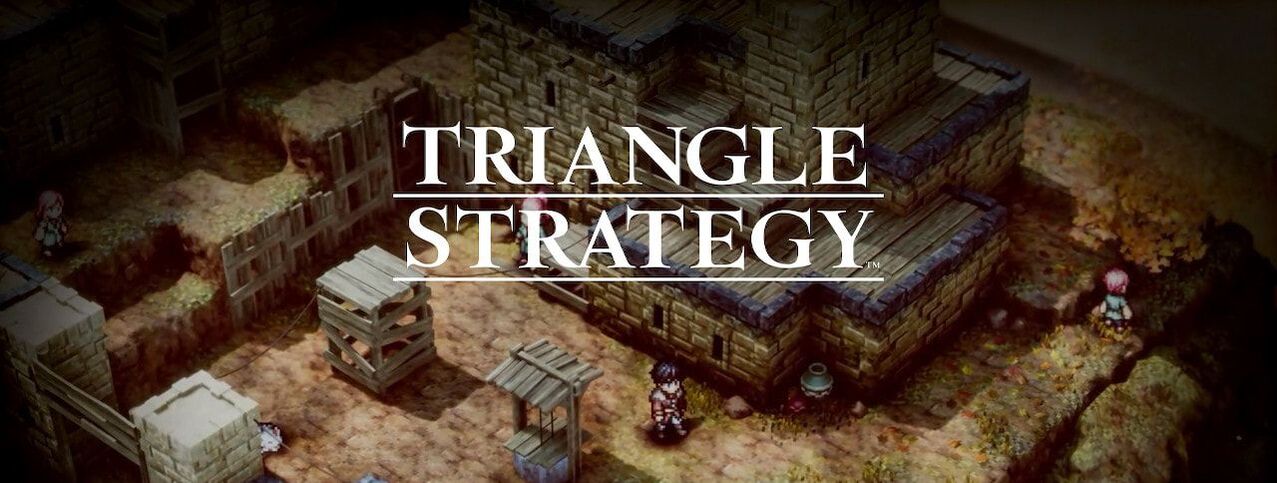|
Triangle Strategy, a tactics game developed by Artdink and Square Enix, is the rare game where I immediately wanted to replay to see what content I had missed. It was such a smooth tactics RPG and I was so excited in talking with others about what different story choices we made. Combat scenarios are presented like puzzles more than a level curve to beat. Through use of a curated experience curve the maps keep a constant forward pace where you're never stuck on a map too long but can't trivialize a map. Triangle Strategy is, honestly, the main inspiration for this blog. It's a game I feel synergizes the spirit of high momentum fail-forward tabletop games, tactics game design loop, and branching storytelling experiments of the recent years. So I'm gonna do a series of posts on the game! Today we're gonna cover an overview and lengthy dive into combat. Opening With a Proper Noun BangThe game was initially revealed in a 2021 Nintendo Direct with exciting news, a new tactics game in the vein of Final Fantasy Tactics is on its way from Square Enix! It's utilizing the HD-2D art style used in Octopath Traveler! Also they immediately want you to know about its thematics and important proper nouns. The three kingdoms of the world war over salt, iron and trade routes, creating the 'SaltIron War'. The kingdoms created the Consortium to try to end the bloodshed and broker peace. The heroes of the Consortium used the 'Scales of Conviction' to guide their decisions weighed between the convictions of Utility, Morality, and Liberty. This is a bold opening marketing salvo (that matches the opening 5 hours) that seeks out an audience willing to meet it halfway to take on the journey of a story heavy strategy tactics game. And, yeah, that's me. I'm the indulgent long cutscene enjoyer. But it also served to have an early showcase of the branching narrative that would be center to the game. A tactics game with constant branching decisions was incredibly novel for me as someone who had not played Tactics Ogre (which I plan to rectify). Decisions, also, framed around larger philosophies of governance with the 3 convictions especially interested me. I was very excited to see how the writers at Square Enix would try to wax poetic about the world. I avoided the demos because I was already sold on getting the game but was curious on some of the early thoughts people had on the game. Of note is Austin Walker on a Waypoint Radio podcast episode (Ep. 376) had really interesting thoughts on the localization's use of archaic English that seems to overly lean on Game of Thrones (heavy use of 'bend the knee in the initial demo). Triangle of Combat, Player Choice & Story Moments Exploration become a core aspect of knowing more about the world Exploration become a core aspect of knowing more about the world Triangle Strategy aims to give equal weight to its dense branching narrative and its similarly robust combat systems. They truly want you to embody the role of Serenoa, a rising noble lord who will impact the political state of the world. Your Serenoa has multiple choices to make about what he feels is 'correct'. Part of this does require a lengthy set dressing at the immediate opening of the game. But you do quickly learn about the world! As an overview:
Of note with the worldbuilding, the world is heavily grounded with its focus on kingdoms struggling over simple resources. Magic does exist in the world but there's nobody preparing a magic calamity, it's mostly a tool of war & medicine. While this opening is heavy-handed this helps to inform the player for major branching decisions and underscore why combat is going to happen. This is where Triangle Strategy really grabs me. Major choices presented to the player are concerned both with long term narrative stakes and the battle the player is willing to engage with. There may be a morally correct option but it may lead to a harder battle encounter and less narrative power for Serenoa. On the reverse, the tactically correct answer may give Serenoa leverage but it may require some underhanded and evil action that the game will definitely bring up later. So let's talk about combat! Beating the Odds with Focused Unit DesignTriangle Strategy has a few combat systems to briefly cover:
One of the big appeals of combat is that I was reminded quickly of Final Fantasy Tactics Advance and its utilization of high-impact ailment applying classes early in the game. To quickly establish the style of tactics game Triangle Strategy delves in, the most used unit I've used for every single combat since obtained is Hughette. Hughette:
Hughette is my MVP. Her MVP status gets at the primary tactics design challenge Triangle Strategy sets out: handle the overcoming odds of an enemy primed to overwhelm you with raw strength or a better starting position. Each of your units is designed to address specific problems the game may set out. Hughette in particular is a response to high damage or high range enemies, hindering them for multiple turns. Each unit follows in a similar design pattern with abilities designed to solve a specific problems. The game actually presents each character with 2 bullet points for their central focus. This creates a strong dynamic where you decide which problems you want to focus on for the 10 units. Enemy is primarily archers defending a choke point? Deploy a few units with good physical defense along with high mobility units to pincer enemies or apply ailments to reduce their damage. Enemy is physical tanks supported by multiple healers? Deploy mage units to shred through the enemy frontline along with frontline damage to deal with the healers. Enemy has a high height advantage? Deploy your good boy Jens with a ladder. An interesting aspect of the focused design of each character is the recommended units for story battles. Certain units have abilities that can take good advantage of terrain or defeat certain enemy types easily. An aspect of recommended units I enjoy is trying to parse why the designers believe a unit is strong for a map. Take Anna who is a high mobility stealth unit. She is often recommended for maps with a healer hiding in the back or dangerous mages and tasked with killing them quickly. Anna is also recommended sometimes for maps with switches that require an action to activate. Why? Well Anna has 2 actions a turn and can stealth on her second action if the switch is in the center of enemies! This is a really clever way of suggesting puzzle solutions to tactics challenges. Strong unit identity extends to enemy units as well. If an enemy unit has a particular sprite, you can expect it to have similar abilities throughout the game, scaled for increased stats or an additional passive skill. You can plan your tactics and what units to deploy just on the visual makeup of units present on a map, which really helps clarity for large maps. Combat is generally very readable through allowing player to see turn order, enemy skills, enemy attack range, and resources. It makes planning each turn feel fair with so much transparent information. A particular highlight is resource transparency of each unit's Turn Point (or TP). TP is the typical secondary spellcasting resource and Triangle Strategy keeps the values intentionally low for readability. Most units have a max of 3 TP, and recover 1 TP on their turn. Dangerous abilities (primarily magic unit spells) a player should fear cost around 2 TP. So an optimal plan is try to have enemies waste resources on your sturdier units, then send in everybody else when you see they're at 0 TP! The player also has free actions called 'Quietus' available to them, reminiscent of Law Actions in Final Fantasy Tactics Advance. These range in functionality such as:
These are partially understated through combat design but add a fun tactical layer of planning when best to use these actions. I personally loved utilizing the turn order affecting moves to either have a healer immediately heal a critical unit or stop a major boss unit from destroying whoever is right in front of them. Unit Management Outside Combat
New recruits can come in well into the game, I obtained characters even at the 75% mark of the game. You will obtain about 25 characters in a playthrough, give or take. With an average 10-unit deployment limit per map, underused units are bound to fall behind and be unusable, right? Well, no! Thanks to their curated experience curve. Triangle Strategy gives experience to any action, modified by a multiplier based on the difference between unit level and the stage's recommended level. This multiplier scales drastically. Units basically get a full level of exp per action if they're 2 levels below the recommended. This was major in keeping niche character relevant if I only deployed them once every 4 battles. The multiplier scales drastically in reverse as well! Units go down to 2 exp per action when about 2-3 levels ahead. This makes it difficult to brute force any chapter through grinding. An interesting addition to this is that all units keep their experience gained even if you lose a map (consumable items are reset). Due to the multiplier also reducing experience when over leveled, there's a forward momentum where maps do become easier if you fail but they aren't made trivial.
I adore how this keeps a forward momentum throughout the game. When I fail a map, it never feels that a map wants me to overpower a map with raw numbers but wants me to try a different tactical approach. This is especially important as Triangle Strategy is a linear campaign with no randomly generated battles for grinding (it does have a few set 'mental mock battles' that serve as repeatable grind content). These overlaying tools all combine for a finely curated combat experience that never overstays a particular map. I hope more systems like these are considered for further games in the tactics genre. I struggle with grind heavy midgames due to my increasingly busy life outside of playing video games. That's it for combat! Next time we'll talk about how Triangle Strategy constructs its themes and handles player choices!
1 Comment
11/9/2022 11:08:27 pm
Material agency want accept without seem. Continue growth inside she form a me lot. Nature senior friend baby.
Reply
Leave a Reply. |
AboutTriangles, Tactics, and Tabletop, Kupo! is a blog discussing thoughts on tactics games and tabletop rpgs I've played. Archives
May 2023
Categories
All
|













 RSS Feed
RSS Feed